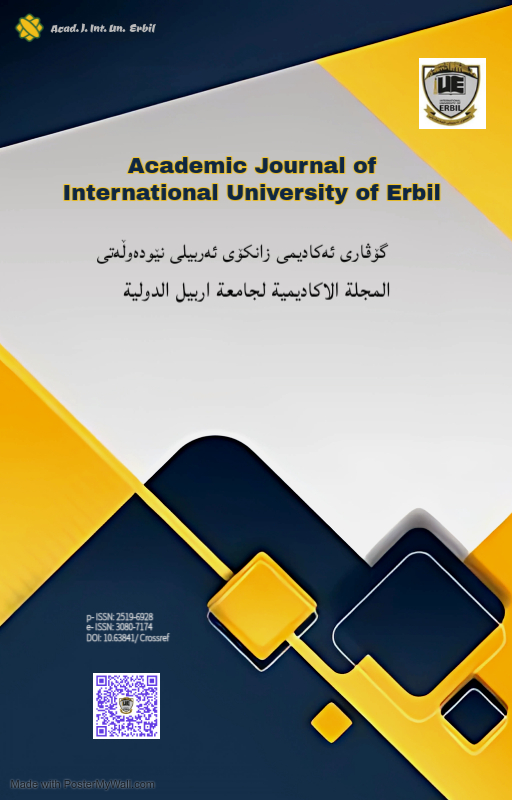Landscape Design for Educational Campuses: The Case of Bakrajo Technical Institute
Landscape Design for Educational Campuses
DOI:
https://doi.org/10.63841/23570Keywords:
Landscape Design, Educational Spaces, Outdoor Learning Environments, Green Infrastructure, Environmental Enhancement, Campus Planning, Student Wellbeing, Ecological DesignAbstract
This study investigates the landscape design at Bakrajo Technical Institute by surveying key stakeholders, including administrative staff, academic staff, and students, to understand their preferences and perceptions. The survey carefully designed and validated by multidisciplinary experts, collected 100 responses that were statistically analyzed to ensure significance.
The results highlight a clear demand for increasing green spaces, shaded and comfortable seating areas, improved lighting, accessible walkways, and clear directional signage. Most respondents (72%) emphasized the importance of incorporating sustainable environmental elements into the design. Accessibility for people with disabilities was also strongly prioritized by 85% of participants.
User preferences showed a strong inclination toward natural and environmental landscape styles (60%) and modern designs (50%), with a notable demand for flowering plants, shade trees, and drought-resistant species. The majority of users frequently visit the institute’s outdoor areas, using them primarily for walking, social interaction, studying, and gatherings.
Key shortcomings identified include inadequate wayfinding, insufficient facilities, and a lack of inclusive design features. Participants expressed a need for multifunctional outdoor spaces that support social, academic, and physical activities. The findings suggest adopting a holistic design approach that integrates aesthetic, social, and ecological considerations, actively involving users to ensure the landscape meets their diverse needs.
Overall, the study underlines the vital role of landscape design in enhancing psychological comfort, promoting active campus life, and fostering a sustainable, inclusive educational environment.
References
D. G. E. Tezgor, & B. K. Aytin, "Landscape Design of University Campuses and User Satisfaction," in Proceedings of the 4th International Conference of Contemporary Affairs in Architecture and Urbanism (ICCAUA2021), vol. 4, no. 1, pp. 158–167, Jun. 2021. Doi: 10.38027/iccaua2021tr0037n21.
L. Macias-Zambrano, E. Cuadrado, & A. J. Carpio, “Factors that determine the connectedness with nature in rural and urban contexts,” PLoS ONE, vol.19, no.8, pp. e0309812, 2024, https://doi.org/10.1371/journal.pone.0309812.
G. A. Lieberman, & L. Hoody, “Closing the achievement gap: Using the environment as an integrating context for learning,” State Education and Environment Roundtable, 1998.
D. Miller, K. Tichota, & J. White, “Young children learn through authentic play in a Nature Explore classroom,” Lincoln, NE: Dimensions Foundation, 2009.
A. Özdemir, & O. Yılmaz, “Assessment of outdoor school environments and physical activity in Ankara’s primary schools,” Journal of Environmental Psychology, vol. 28, no. 3, pp. 287–300, 2008.
D. Çukur, & H. Özgüner, “Kentsel alanda çocuklara doğa bilinci kazandırmada oyun mekanı tasarımının rolü,” Süleyman Demirel Üniversitesi Orman Fakültesi Dergisi, vol.A, no.2, pp. 177–187, 2008.
P. Blatchford, “Social life in school: Pupils’ experience of breaktime and recess from 7 to 16 years. Falmer Press, Taylor & Francis Group, 1998.
H. Algan, & C. Uslu, “İlköğretim okul bahçelerinin tasarlanmasına paydaş katılımı: Adana örneği,” Akdeniz Üniversitesi Ziraat Fakültesi Dergisi, vol. 22, no. 2, pp. 129–140, 2009.
J. E. Dyment, “Green school grounds as sites for outdoor learning: Barriers and opportunities,” International Research in Geographical and Environmental Education, vol.14, no.1, pp.28-45, 2005.
K. Kucks and L. Hughes, “Children, outdoor play, and design: Learning in green environments,” Childhood Educ., 2019.
E. Stanton et al., “Learning for well-being: A review of learning environments that support student flourishing,” 2016.
M. Ersoy, “Kentsel alan kullanım normları (Yayın No: 94.02). O.D.T.Ü,” Mimarlık Fakültesi, 1994.
K. Bakan, & G. Konuk, “Türkiye'de kentsel dış mekanların düzenlenmesi,” Tübitak Yapı Araştırma Enstitüsü Yayın No: US, 1987.
G. Akdoğan, “Beş büyük şehirde çocuk oyun alanlarının yeterlikleri ve planlama prensipleri üzerinde bir araştırma,” Ankara Üniversitesi Ziraat Fakültesi Yayınları, 1972.
I. Fjørtoft and J. Sageie, “The natural environment as a playground for children: Landscape description and analyses of a natural playscape,” Landscape and Urban Planning, vol. 48, pp. 83–97, 2000.
F. Tanrıverdi, “Bahçe sanatının temel ilkeleri ve uygulama metodları,” Atatürk Üniversitesi Yayınları No: 643, 1987.
G. Uzun, Kentsel rekreasyon alan planlaması (Ders Kitabı No: 48). Çukurova Üniversitesi Ziraat Fakültesi Peyzaj Mimarlığı Bölümü, 1990
M. Erdönmez, “İlköğretim okul bahçelerinde peyzaj normları,” İstanbul Üniversitesi Orman Fakültesi Dergisi, vol. 57, no. 1, pp. 107-122, 2007.
G. Carrus, S. Pirchio, Y. Passiatore, S. Mastandrea, M. Scopelliti, & G. Bartoli, “Contact with nature and children's wellbeing in educational settings,” Journal of Social Sciences, vo.8, no.3, pp.304-309, 2012.
E. Largo-Wight, C. Guardino, P. S Wludyka, K. W Hall, Jeff T Wight, J. W Merten “Nature contact at school: The impact of an outdoor classroom on children’s well-being,” International Journal of Environmental Health Research, vol.28, no.6, pp.653-666, 2018, doi: 10.1080/09603123.2018.1502415
W. Grant, Landscape Planning and Environmental Impact Design. Oxford, UK: Wiley-Blackwell, 2009.
A. Wright and D. Johnson, “The role of green spaces in enhancing urban environments,” Urban Des. Int., vol. 18, no. 3, pp. 171–183, 2013.
C. Gillis and M. Stafford, “Sustainable landscaping: Designing for efficiency and aesthetics,” Landscape Urban Plan., vol. 142, pp. 122–135, 2016.
R. Ewing and R. Cervero, “Travel and the built environment: A meta-analysis,” J. Am. Plann. Assoc., vol. 76, no. 3, pp. 265–294, 2010.
R. Kaplan and S. Kaplan, The Experience of Nature: A Psychological Perspective. Cambridge, UK: Cambridge University Press, 1989.
J. Punter, “Urban Design and Sustainability: A Global Perspective,” London, UK: Routledge, 2007.
F. D. K. Ching, “Building Construction Illustrated,” 5th ed. Hoboken, NJ: John Wiley & Sons, 2014.
M. Gerrard, “Architectural Drafting and Design,” 6th ed. Clifton Park, NY: Delmar Cengage Learning, 2007.
M. J. Riley, “Construction Materials, Methods, and Techniques: Building for a Sustainable Future,” 3rd ed. Clifton Park, NY: Cengage Learning, 2013.
Bureau of Indian Standards, National Building Code of India 2016, 2nd ed. New Delhi, India: BIS, 2016.
B. Dvorak, “Plant Selection for Landscape Architecture: A Guide for Design Professionals” New York, NY: McGraw-Hill Education, 2002.
D. Sayers, & R. Preece, “Landscape Irrigation: Design and Management,” Hoboken, NJ: John Wiley & Sons, 2016.
M. Murphy, “Architectural Construction: Principles, Materials, and Techniques,” New York, NY: McGraw-Hill, 2008.
M. Calkins, “The Sustainable Sites Handbook: A Guide to the Principles, Strategies, and Best Practices for Green Design and Construction,” Hoboken, NJ: Wiley, 2004.
W. Larcher, “Physiological Plant Ecology: Ecophysiology and Stress Physiology of Functional Groups,” Berlin, Germany: Springer, 2003.
M. Mazzarella, & B. Dancik, “Sustainable Landscaping: Designing with Native Plants,” Berkeley, CA: University of California Press, 2017.
Olea europaea (Olive Tree): How to Grow and Care with Success, Gardenia.net. [Online]. Available: https://www.gardenia.net/plant/olea-europaea. [Accessed: May 31, 2025].
S. Mernick, & L. Raftery, “The Landscape Design Portfolio,” London, UK: Thames & Hudson, 2005.
J. Vogt, “Urban Green Spaces: Designing for People,” London, UK: Routledge, 2014.
R. Kopp, “Landscape Maintenance: Best Practices for Health and Longevity,” New York, NY: McGraw-Hill Education, 2013.
Downloads
Published
Issue
Section
License
Copyright (c) 2025 Academic Journal of International University of Erbil

This work is licensed under a Creative Commons Attribution-NonCommercial-NoDerivatives 4.0 International License.












